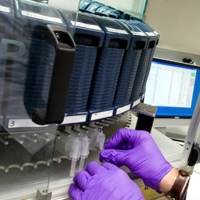Methods and Rationale for the Early Detection of Pancreatic Cancer
Abstract
Pancreatic cancer often presents at an advanced stage that result in a very dismal five-year survival rates. Novel methods to detect tumors as early as possible are desperately needed. The U.S. Preventive Services Task Force (USPSTF) recommends against routine screening for pancreatic cancer in asymptomatic adults using abdominal palpation, ultrasonography, or serologic markers. The evidence for diet-based prevention of pancreatic cancer is limited and conflicting. Recommendations about lifestyle changes, such as stopping the use of tobacco products, moderating alcohol intake, and eating a balanced diet with sufficient fruit and vegetables is generally made. However, screening for persons with hereditary predisposition to develop pancreatic cancer has not been included in this review. Biomarkers represent one tool for the early detection of small, surgically resectable cancers in both the general and high risk populations. Some of the currently utilized biomarkers including carcinoembryonic antigen (CEA), CA 19-9, SPan-1, and DUPAN-2 unfortunately have yet to show the sensitivity and specificity needed to be used for screening asymptomatic patients in the general population for pancreatic cancer. Herein, the authors report some updated information from the 2010 ASCO Gastrointestinal Cancers Symposium in detecting early stage pancreatic cancer.
Image: From the Pharmacology Department, Yale University School of Medicine. New Haven, CT, USA.
Downloads
References
Jemal A, Siegel R, Ward E, Hao Y, Xu J, Thun MJ. Cancer Statistics, 2009. CA Cancer J Clin 2009; 59:225-49. [PMID 19474385] (FULL TEXT: http://caonline.amcancersoc.org/cgi/content/full/59/4/225)
Geer RJ, Brennan MF. Prognostic indicators for survival after resection of pancreatic adenocarcinoma. Am J Surg 1993; 165:68-72. [PMID 8380315] (FULL TEXT: http://www.sciencedirect.com/science?_ob=MImg&_imagekey=B6VHS-4KSRVNW-F-1&_cdi=6074&_user=839424&_pii=S0002961005804064&_orig=browse&_coverDate=01%2F31%2F1993&_sk=998349998&view=c&wchp=dGLzVlz-zSkWA&md5=a41bf6cf9a4a4874a659087ad3745918&ie=/sdarticle.pdf)
Ariyama J, Suyama M, Satoh K, Sai J. Imaging of small pancreatic ductal adenocarcinoma. Pancreas 1998; 16:396-40. [PMID 9548685] (FULL TEXT: http://journals.lww.com/pancreasjournal/pages/articleviewer.aspx?year=1998&issue=04000&article=00030&type=abstract)
Bilimoria KY, Bentrem DJ, Ko CY, Stewart AK, Winchester DP, Talamonti MS. National failure to operate on early stage pancreatic cancer. Ann Surg 2007; 246:173-80. [PMID 17667493] (FULL TEXT: http://journals.lww.com/annalsofsurgery/pages/articleviewer.aspx?year=2007&issue=08000&article=00003&type=abstract)
Agency for Healthcare Research and Quality (AHRQ). Screening for Pancreatic Cancer. Recommendation Statement. U.S. Department of Health & Human Services Washington, DC, USA, 2004. (FULL TEXT:http://www.ahrq.gov/clinic/3rduspstf/pancreatic/pancrers.htm)
Andrén-Sandberg A. 4th international symposium on inherited diseases of the pancreas. November 7-9, 2003, Chicago, Ill., USA. Pancreatology 2003; 3:520-32. [PMID 14752237] (FULL TEXT: http://content.karger.com/ProdukteDB/produkte.asp?Aktion=ShowFulltext&ArtikelNr=76367&Ausgabe=229783&ProduktNr=224334)
Brand RE, Lerch MM, Rubinstein WS, Neoptolemos JP, Whitcomb DC, Hruban RH, et al. Advances in counselling and surveillance of patients at risk for pancreatic cancer. Gut 2007; 56:1460-9. [PMID 17872573] (FULL TEXT: http://gut.bmj.com/content/56/10/1460.long)
Poley JW, Kluijt I, Gouma DJ, Harinck F, Wagner A, Aalfs C, et al. The yield of first-time endoscopic ultrasonography in screening individuals at a high risk of developing pancreatic cancer. Am J Gastroenterol 2009; 104:2175-81. [PMID 19491823] (FULL TEXT: http://www.nature.com/ajg/journal/v104/n9/full/ajg2009276a.html)
Gold DV, Goggins M, Newsome G, Modrak DE, Liu M, Goldenberg DM. The PAM4 serum enzyme immunoassay (EIA) for detection of early-stage pancreatic carcinoma. 2010 ASCO Gastrointestinal Cancers Symposium. Abstract No. 135. (FULL TEXT:http://www.asco.org/ASCOv2/Meetings/Abstracts?&vmview=abst_detail_view&confID=72&abstractID=1936)
Gold DV, Lew K, Maliniak R, Hernandez M, Cardillo T. Characterization of monoclonal antibody PAM4 reactive with a pancreatic cancer mucin. Int J Cancer 1994; 57:204-10. [PMID 7512537]
Gold DV, Karanjawala Z, Modrak DE, Goldenberg DM, Hruban RH. PAM4-reactive MUC1 is a biomarker for early pancreatic adenocarcinoma. Clin Cancer Res 2007; 13:7380-7. [PMID 18094420] (FULL TEXT: http://clincancerres.aacrjournals.org/content/13/24/7380.long)
Gold D, Modrak DE, Newsome G, Karanjawala Z, Hruban R, Goggins M, Goldenberg DM. Detection of early-stage pancreatic carcinoma. J Clin Oncol 2009; 27(15 Suppl):Abstract 4613. (FULL TEXT:http://meeting.ascopubs.org/cgi/content/abstract/27/15S/4613)
Gold DV, Modrak DE, Ying Z, Cardillo TM, Sharkey RM, Goldenberg DM. New MUC1 serum immunoassay differentiates pancreatic cancer from pancreatitis. J Clin Oncol 2006; 24:252-8. [PMID 16344318] (FULL TEXT: http://jco.ascopubs.org/cgi/content/full/24/2/252)
Ni XG, Bai XF, Mao YL, Shao YF, Wu JX, Shan Y, et al. The clinical value of serum CEA, CA19-9, and CA242 in the diagnosis and prognosis of pancreatic cancer. Eur J Surg Oncol 2005; 31:164-9. [PMID 15698733] (FULL TEXT: http://www.sciencedirect.com/science?_ob=MImg&_imagekey=B6WF4-4DH2B4M-5-1&_cdi=6784&_user=839424&_pii=S074879830400263X&_orig=browse&_coverDate=03%2F01%2F2005&_sk=999689997&view=c&wchp=dGLbVzW-zSkWb&md5=bec9794e6eaef1b6e5180fa47675ed48&ie=/sdarticle.pdf)
Simeone DM, Ji B, Banerjee M, Arumugam T, Li D, Anderson MA, et al. CEACAM1, a novel serum biomarker for pancreatic cancer. Pancreas 2007; 34:436-43. [PMID 17446843] (FULL TEXT: http://journals.lww.com/pancreasjournal/pages/articleviewer.aspx?year=2007&issue=05000&article=00009&type=abstract)
Kiriyama S, Hayakawa T, Kondo T, Shibata T, Kitagawa M, Ono H, Sakai Y. Usefulness of a new tumor marker, Span-1, for the diagnosis of pancreatic cancer. Cancer 1990; 65:1557-61. [PMID 2311067] (FULL TEXT: http://www3.interscience.wiley.com/cgi-bin/fulltext/112686733/PDFSTART)
Goonetilleke KS, Siriwardena AK. Systematic review of carbohydrate antigen (CA19-9) as a biochemical marker in the diagnosis of pancreatic cancer. Eur J Surg Oncol 2007; 33:266-70. [PMID 17097848] (FULL TEXT: http://www.sciencedirect.com/science?_ob=MImg&_imagekey=B6WF4-4M9H3ND-1-1&_cdi=6784&_user=839424&_pii=S0748798306003763&_orig=browse&_coverDate=04%2F30%2F2007&_sk=999669996&view=c&wchp=dGLbVlW-zSkWz&md5=9fe2b3d7ca8d477b9a27a6c154195c9d&ie=/sdarticle.pdf)
Koopmann J, Rosenzweig CN, Zhang Z, Canto MI, Brown DA, Hunter M, et al. Serum markers in patients with resectable pancreatic adenocarcinoma: macrophage inhibitory cytokine 1 versus CA19-9. Clin Cancer Res 2006; 12:442-6. [PMID 16428484 http://clincancerres.aacrjournals.org/content/12/2/442.long)
Ishizone S, Yamauchi K, Kawa S, Suzuki T, Shimizu F, Harada O, et al. Clinical utility of quantitative RT-PCR targeted to alpha1,4-N-acetylglucosaminyltransferase mRNA for detection of pancreatic cancer. Cancer Sci 2006; 97:119-26. [PMID 16441422] (FULL TEXT: http://www3.interscience.wiley.com/cgi-bin/fulltext/118566398/HTMLSTART)
Matsubayashi H, Canto M, Sato N, Klein A, Abe T, Yamashita K, et al. DNA methylation alterations in the pancreatic juice of patients with suspected pancreatic disease. Cancer Res 2006; 66:1208-17. [PMID 16424060] (FULL TEXT: http://cancerres.aacrjournals.org/cgi/content/full/66/2/1208)
Wu X, Lu XH, Xu T, Qian JM, Zhao P, Guo XZ, Yang XO, Jiang WJ. Evaluation of the diagnostic value of serum tumor markers, and fecal k-ras and p53 gene mutations for pancreatic cancer. Chin J Dig Dis 2006; 7:170-4. [PMID 16808798] (FULL TEXT: http://www3.interscience.wiley.com/cgi-bin/fulltext/120718474/HTMLSTART)

Copyright (c) 2010 Scott Bussom, Muhammad Wasif Saif

This work is licensed under a Creative Commons Attribution 4.0 International License.
As a member of Publisher International Linking Association, PILA, iMedPub Group’s JOP follows the Creative Commons Attribution License and Scholars Open Access publishing policies. Journal of the Pancreas is the Council Contributor Member of Council of Science Editors (CSE) and following the CSE slogan Education, Ethics, and Evidence for Editors.